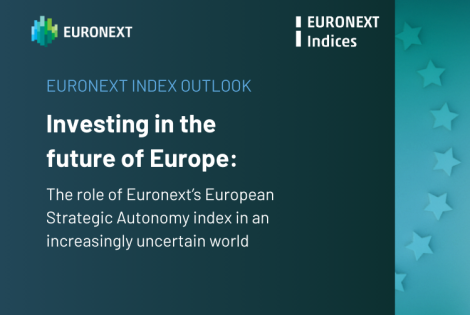-
Listing
-
Informazioni sul trading
 Where European Government Bonds meet the futureFixed Income derivativesLeggi tutto
Where European Government Bonds meet the futureFixed Income derivativesLeggi tuttoTrade Mini Bond Futures on main European Government Bonds
-
Clearing
 Step into Europe’s next phase of Repo ClearingRepo ClearingLeggi tutto
Step into Europe’s next phase of Repo ClearingRepo ClearingLeggi tuttoEuronext is expanding its repo clearing services to boost market access, liquidity provision and collateral optimisation across Europe.
-
CSD
 European CSD modelBuilding the CSD of Choice in EuropeLeggi tutto
European CSD modelBuilding the CSD of Choice in EuropeLeggi tuttoEuronext Securities is shaping the future of European capital markets by enhancing integration, connectivity, and innovation.
-
Technology
 Euronext Technology SolutionsHigh-Frequency Trading Solution (HFTS)Leggi tutto
Euronext Technology SolutionsHigh-Frequency Trading Solution (HFTS)Leggi tuttoThe new generation of high-frequency risk trading platforms, offering the highest performance with ultra-low latency and minimal jitter, all at a low total cost of ownership.
-
Data
-
Indices
 Access the white paperInvesting in the future of Europe with innovative indicesLeggi tutto
Access the white paperInvesting in the future of Europe with innovative indicesLeggi tuttoThe first edition of the Euronext Index Outlook series with a particular focus on the European Strategic Autonomy Index.
- Regulation
-
About Euronext
 Euronext strategic planInnovate for Growth 2027Leggi tutto
Euronext strategic planInnovate for Growth 2027Leggi tuttoShaping capital markets for future generations
-
Listing
-
Informazioni sul trading
 Where European Government Bonds meet the futureFixed Income derivativesLeggi tutto
Where European Government Bonds meet the futureFixed Income derivativesLeggi tuttoTrade Mini Bond Futures on main European Government Bonds
-
Clearing
 Step into Europe’s next phase of Repo ClearingRepo ClearingLeggi tutto
Step into Europe’s next phase of Repo ClearingRepo ClearingLeggi tuttoEuronext is expanding its repo clearing services to boost market access, liquidity provision and collateral optimisation across Europe.
-
CSD
 European CSD modelBuilding the CSD of Choice in EuropeLeggi tutto
European CSD modelBuilding the CSD of Choice in EuropeLeggi tuttoEuronext Securities is shaping the future of European capital markets by enhancing integration, connectivity, and innovation.
-
Technology
 Euronext Technology SolutionsHigh-Frequency Trading Solution (HFTS)Leggi tutto
Euronext Technology SolutionsHigh-Frequency Trading Solution (HFTS)Leggi tuttoThe new generation of high-frequency risk trading platforms, offering the highest performance with ultra-low latency and minimal jitter, all at a low total cost of ownership.
-
Data
-
Indices
 Access the white paperInvesting in the future of Europe with innovative indicesLeggi tutto
Access the white paperInvesting in the future of Europe with innovative indicesLeggi tuttoThe first edition of the Euronext Index Outlook series with a particular focus on the European Strategic Autonomy Index.
- Regulation
-
About Euronext
 Euronext strategic planInnovate for Growth 2027Leggi tutto
Euronext strategic planInnovate for Growth 2027Leggi tuttoShaping capital markets for future generations
- Home
- About
- Media centre
- Bell Ceremony Archive
- Euronext’s key role in financing European companies
Euronext’s key role in financing European companies
10/02/2014
For Euronext, 2013 will be remembered as the year our markets returned to business as usual. Although the economic environment remains challenging in many European countries, Euronext’s markets played a major role in financing companies of all sizes in every sector. Companies raised €92 billion in 2013 on our markets, compared with €83 billion the previous year, including €29.4 billion in equity and quasi-equity and €62.3 billion in bonds. The largest operations included Numéricable’s that raised €750 million with its IPO in Paris, as well two other French operations: Alcatel Lucent’s €1 billion capital increase and EDF’s €1.4 billion bond issue. In Belgium, bpost raised €812 million with its IPO and in PortugaVEl, postal operator CTT raised nearly €580 million early December when it entered the market in Lisbon. In Amsterdam, we had the interesting OCI technical listing (listing and exchange offer of € 6.2 billion Market Cap).
Nearly forty new entries on the market were completed last year, including more than 20 IPOs which raised in excess of €3 billion, a level of financing that had not been achieved since 2007.
“These figures and operations testify the central role played by Euronext in the financing of the European economy. We work constantly to increase transparency, efficiency and security while monitoring our markets in order to attract investors to the exchange and support business growth,” said Marc Lefèvre, Director, Head of European Business Development & Client Coverage, Euronext. “It can be said that a positive sentiment and momentum is back on our Markets.”
There are several reasons for this successful development. Firstly, investors and individuals in the market have been reassured by rising indices following several years of recession. The CAC 40 rose 17.99% in 2013, the AEX 17.24%, the BEL 20 by 18.10% and the PSI 20 by 15.98%. At the same time, volatility has dropped to low levels, which is necessary for a dynamic market of new introductions on the exchange. The VSTOXX volatility index which had risen to almost 60% in 2009 dropped to 17% at the end of 2013, the same level as before the recession in 2007.
Among the reasons for the exchange’s return to centre stage is a dual redistribution between stocks and bonds in favour of the former on the one hand, and geographically between the United States and Europe with the latter in particular thriving. The valuations achieved also enable investment funds to sell some of their holdings via listings on the market.
After a very encouraging 2013, Euronext is expecting a confirmation of these trends in 2014.

